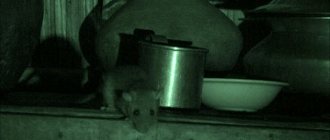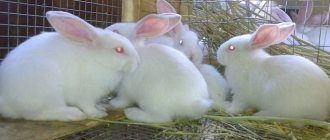Some rabbit owners, observing their charges, suspect that they have vision problems. It seems to them that the animal does not recognize its owner or does not see objects located directly in front of its muzzle. The thing is that the eyes of these animals are structured differently than those of people: they perceive the world completely differently. How rabbits see and whether they distinguish colors will be discussed in this article.
Rabbit looking at the camera
Why does a rabbit need eyes?
In nature, long-eared animals live in deep burrows where there is complete darkness. There the human eye is completely useless. You can’t help but wonder: Do rabbits even see? Over the course of their long evolution, animals have learned to navigate well in absolute darkness. This necessarily affected the structure of the eyes.
Humans use vision to find food. The eared animal needs its eyes more to maintain safety in order to see the predator in a timely manner. The animal's vision is designed so that it can see almost 360o. This is facilitated by large eyes placed high on the sides of the muzzle. A small dead zone remains the space directly in front of the nose and behind the ears.
It's interesting how rabbits see food. Anyone familiar with long-eared animals will have noticed that at close range our pet tries to turn sideways. In addition, the animal is well helped by tactile receptors located at the tips of its whiskers.
Difference from man
In humans, the eyes are located at the front of the head. This arrangement was formed during evolution. Primates obtained food using their hands. In order to see future food and, for example, pick it, it was necessary to be able to examine it itself and the place where it is located, both near and at a distance.
Wild rabbits had a different task. The main thing for them was the opportunity to dodge numerous predators, for whom they themselves could become tasty food. If they had to turn around to look at their surroundings from the side and behind, then precious seconds would be lost.
The location of rabbits' visual organs on both sides of the head provides them with an almost 360-degree view. Rodents are especially good at distinguishing objects located in the distance.
Features of the structure of the eyes
By and large, the structure of a rabbit's eyes is not very different from this organ in any warm-blooded animal. The large eyeball, located in the orbit, like in any animal, is connected to the brain through a special optic nerve. The internal structure of an apple is completely standard - the lens and vitreous body, as well as the contents of two chambers. All this is penetrated by nerve vessels and protected by a membrane. This structure determines how rabbits see our world.
Unlike humans, furry companions have three eyelids covering their eyes. The two perform functions similar to the upper and lower eyelids in humans. The third serves to protect the sebaceous gland and is located near the inside of the eye. The outside of the eye is covered with a thick coating, thanks to which rabbits practically do not blink.
Rabbit irises come in a wide variety of colors. Among decorative breeds, eyes that match the color of the fur are valued.
What colors do rabbits see?
The human visual organs are designed in such a way that they are able to perceive the world around us in all its abundance of colors. Thanks to the cones and rods that are found in the eyeballs, people distinguish between three primary colors:
- red;
- green;
- blue.
People distinguish three primary colors, but rabbits only two
Unlike people, long-eared pets have a more primitive visual apparatus; they are able to distinguish only two colors - blue and green.
Nature made sure that rabbits could recognize the approach of danger in time and hide from it. Their organs of vision differ from human ones in their structure and location, but they cannot be considered imperfect. The visual apparatus of eared animals operates in conjunction with other senses - touch, smell and hearing, which allows animals to navigate well in space even in the dark.
How do rabbits see?
Like many warm-blooded animals, baby rabbits are born completely blind. After reaching two weeks they begin to see. The long-eared one has monocular vision. In other words, each object is viewed with one eye. The total horizon covers 360o and the intersection occurs in front at 27o and partially behind at 9o. This property determines how well the rabbit sees everything on the sides and behind, but does not distinguish at all what is in front of its nose. To see an object in the dead zone, the animal is forced to turn its head. But everything is clearly visible all around. Anyone who might cause trouble is targeted. Monocular vision helps well to notice the approach of an enemy in time.
Differences in eye structure between humans and rabbits
A person's eyes are located in the front of the head. This arrangement was formed during evolution. In order to survive, a person had to constantly look for food. To do this, he used his eyes and hands. The location of the eyeballs in the front of the head is ideal for a person: he can see perfectly in front of him, both near and at a long distance. But people are unable to discern what is happening behind them. To view objects behind them, they need to turn their head or entire body. It's different for rabbits.
The eyes of the long-eared pet are located on both sides of the head. The evolution of these animals happened differently. The rabbit is a defenseless creature; it serves as a source of food for many wild animals, as well as for humans. This means that the animal’s main task is to recognize danger in time and hide. In order to see his enemy wherever he is, the rabbit's eyes are formed in such a way that he can see almost 360 degrees. The pet is especially good at distinguishing objects located in the distance. The rabbit also has excellent orientation in the dark.
Despite some advantages of the structure of rabbit eyes, they also have disadvantages:
- Blind area. The long-eared rodent is able to see everything that is on the side of it and even behind it, but it does not see directly in front of it. The placement of his eyes prevents him from doing this.
- Lack of image clarity. A rabbit does not see the world around it as clearly as a human. Pictures turn out slightly blurry, regardless of the level of illumination.
If you put a carrot in front of your pet, he will, of course, find it thanks to his excellent sense of smell, but in order to examine it, the animal will turn sideways to it.
The rabbit has senses of touch - antennae.
To recognize objects located directly in front of the pet's muzzle, it has sense organs - antennae. Interestingly, a rabbit may not recognize its owner if he picks up a large object. Then the previously familiar outlines of the body will take a different shape, so the animal may get scared. This is why many pet owners think their pets have vision problems.
Interesting! The rabbit sees its owner as a big blur.
Vision in the dark
Another important feature is how rabbits see in the dark. For an animal there is practically no difference between day and night. His vision works equally well. True, it is believed that a rabbit’s worldview is not as clear as that of a human. Perhaps his vision of the world is like a blurry picture. As soon as the owner picks up a large box, the animal will be confused. The owner's voice and smell are familiar, but the picture is different. When communicating with a pet, this should be taken into account, especially at the adaptation stage. The rabbit is a rather fearful animal.
Of course, rabbits feel absolutely comfortable in the dark. The main time of activity occurs during twilight and the time before sunrise. But we must not forget that rabbits need daylight. Light greatly affects the productivity and growth rate of babies.
The structure of vision in rabbits: what and how they see
Domestic rabbits have retained many of the physiological characteristics of their wild counterparts. However, many years of captivity and selection also affected the structure of the animals’ bodies, which caused changes in some biological characteristics. This concerns the organs of perception, since at home the instinct of self-defense weakens in animals. We suggest you find out in our article whether these changes have affected the eyes and what kind of vision the rabbits have.
Color perception
It seems completely natural for a person to look at the world in all its colors. The world is filled with a wide variety of shades of blue, red, green. But it’s not like that for our students. For many years, experts believed that the rabbit sees the world like a black and white movie. There are only shades of gray. But scientists were able to determine that this was not the case. It has been proven that the long-eared eye is able to distinguish between green and blue colors. Accordingly, all their shades and intersections. This is not such a rich world as a person’s, but also not as poor as a solid gray one. However, the question remains open of how animals perceive these colors. Today it is difficult to talk about this.
Another feature of rabbits’ vision can be considered that they practically do not close their eyes during sleep. It is difficult to say whether the video signal is being processed at this time or not, but they sleep very lightly. The slightest movement nearby and the animal wakes up.
From what has been said, it is clear: in order to understand how our pets perceive the world, we need to get acquainted with the characteristics of their senses. This will undoubtedly help you better manage your pets' behavior. Makes communication with them more interesting.
Color Distinction
The question of the color perception of the environment by animals has been of concern to scientists for a long time, and therefore has been well studied. It's safe to say that rabbits distinguish colors, just not in the same way as humans. Like other vertebrates, their retina has photoreceptive cells - cones and rods. A study of the color perception of the world by animals, which was carried out in the 70s of the last century, showed that rabbits see colors, but in limited quantities. Human vision is adapted to perceive three primary colors: red, blue, green. Rabbits perceive only two: blue and green.
To obtain a complete picture, animals use not only vision, but also excellent sense of smell and hearing.
In addition to vision, rabbits navigate using hearing and smell.
Are rabbits afraid of the dark?
Rabbits are not afraid of the dark , but they do tend to get a little nervous the darker it gets.
The reason for this is quite logical. If they cannot rely on their vision, they have to rely on other senses. Now their hearing and smell come into play. These senses become much more sensitive at night, meaning that the rabbit will also be more alert.
Pet owners tend to confuse this sudden alertness with fear, when in fact it is not. Simply put: although rabbits are not afraid of the dark, they just want to make sure there is nothing in the dark that they should be afraid of.
Are rabbits afraid of the dark?
Rabbits are adorable, but are they afraid of the dark? They are also one of the most vulnerable animals. In the wild, they are often considered prey for larger predators such as lions and tigers. However, at home, rabbits are easily startled or surprised, even if there are no predators nearby.
Are rabbits afraid of the dark? Essentially, they are not afraid of the dark. However, they become more alert to what might follow them in the dark. Pet owners usually misunderstand this as fear, but in reality it is much more complex.
Do rabbits need darkness to sleep?
Although many people think that rabbits are nocturnal, this is actually not the case. Contrary to popular belief, rabbits are actually crepuscular animals, meaning that they tend to be more active at dusk, or between dawn and dusk. Their status as predatory animals makes it difficult for them to remain awake during the bright daylight hours. However, it is also difficult to navigate in pitch darkness. The dim light at dusk and dawn is the ideal time for them to go about their business in relative safety.











